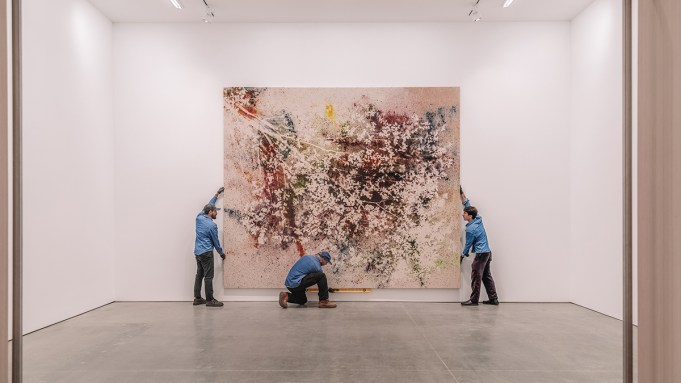As soon as wildfires began ravaging Los Angeles this past January, art adviser and collection manager Karyn Lovegrove and her team sprang into action. After consulting their collection-management database to determine which clients had art near the rapidly spreading evacuation zones, “we made the decision to empty out some of the houses that we work in as a way to be proactive,” she says. They swiftly de-installed two major private collections in Los Feliz and the Hollywood Hills, packing each piece in a purpose-built crate, moving the work into storage, and updating insurance companies once everything was out of harm’s way. “We were emptying houses in three hours,” Lovegrove explains. “We are very aware being in California that we have earthquakes, we have water damage, we have fires. So we were extremely well prepared.”
Lovegrove wasn’t alone in providing emergency art-protection services. Storage companies such as Crozier and Uovo: Art, Fashion, and Wine were also rushing to help clients. Carolyn Page-Katz, Uovo’s president and COO, says the firm often de-installs artwork from homes before tropical storms or hurricanes in states like Florida, where there’s advance warning. But when it came to the Los Angeles blaze, “everything was moving very quickly,” she recalls. “We arranged to meet people in evacuation zones. We were also staying open late to allow people to drop off. We tried to be as flexible as possible.”
An art-forward beach house in Tofino, Canada, designed by Olson Kundig.
Nic Lehoux
In a world where once-in-a-lifetime events such as fires, floods, and hurricanes are becoming increasingly routine, it seems that preparation has become the mantra. “What we have seen post this particular fire,” says Page-Katz, “is people thinking about having a plan.” That can include everything from establishing a relationship with a moving company before disaster strikes to splitting a collection between different homes or storage locations.
Insuring high-value work is also a smart move. During the Los Angeles wildfires, a few insurance carriers came to clients’ aid, retrieving art for safekeeping and sending private firefighters to protect homes by dampening them to prevent flying sparks from starting a blaze, says Jeff Newman of the brokerage Hub International. “It helps the client, but it also helps the insurance companies, because they want to protect their exposure.”
When thinking about insurance, research is important, as many carriers have recently stepped back from the California market, with more likely to follow, Newman says. Some premier insurers, like Chubb and Pure, are more hands-on, collaborating with clients to mitigate loss before it happens. Lovegrove says the insurance companies her clients work with make it easy to keep collections databases updated and offer specific recommendations about which works should stay in storage or how collectors can disaster-proof their homes.
“You can’t prevent a natural disaster,” says Jerry Podany, the former head of antiquities conservation at the Getty Museum, who now works as a heritage-preservation consultant. “But you can dramatically reduce, and even prevent, major damage, and it’s not rocket science.”

The firm is known for designing houses around its clients’ art collections.
Bruce Van Inwegen
Until his 2016 retirement, Podany was part of the team that developed the strategies and response plan that kept both of the institution’s campuses—the Getty Villa and the Getty Center—relatively unscathed in the recent fires. Their approach largely involved being “obsessive,” Podany says, about using nonflammable building materials, keeping the area free of combustible vegetation, and “assuring proper ventilation control to prevent smoke and pollutants from entering the building.”
At his own home near Hancock Park, he does “the things that are common sense, like bolting the house down to the foundation and making sure that we’ve got any kind of tree or brush clear of the building, and that we have an evacuation plan,” while small objects are secured with microcrystalline wax. Known as museum mounting wax, the product comes in a solid block and acts as an adhesive for small objects, preventing them from toppling off their display stands due to an earthquake or accidental bump from kids, pets, or partygoers.
When Podany consults privately—his specialization is earthquake-damage mitigation and disaster response—his first suggestion is always “take the heavy thing on the top shelf and put it on the bottom shelf. You’ve already reduced your vulnerability dramatically.” More-complex solutions, which center on customized storage and display options, range from hiring a mount-maker to creating a base-isolation unit—a specialized earthquake mount pioneered by his department at the Getty.

Although threatened by January’s wildfires in Los Angeles, the Getty Villa art museum remained safe thanks to years of preventative planning.
David Swanson/AFP via Getty Images
“It’s not like there’s some magic formula” to avoid damage for every extreme event, says Daniel Ralls, a principal in the Seattle-based global architecture firm Olson Kundig. But in general, he says “making as many sensible choices as you can feels like a good idea.” For flood-prone areas, this includes raising the floor above the flood line and integrating flood gates (adjustable units meant to mitigate water flow) into perimeter fencing. In fire-sensitive areas, exterior building materials might include concrete, stone, or steel with an intumescent coating, which is meant to slow the spread of a burn, giving occupants more time to escape. When it comes to interiors, many collectors love the idea of waterless sprinkler systems, however they aren’t an ideal choice for a home, because they function by sucking the oxygen out of the air. Ralls says that Olson Kundig typically opts for the VESDA smoke-detection system, which continuously samples the air through tiny “sniffer” holes, combined with another “pre-action” system that readies the sprinklers when smoke is detected—but releases water only once fire is confirmed.
The key is that “it’s not just one strategy,” says Ralls. “For the most part,” he adds, “if we do what’s good for the people who occupy our homes, it’s good for the art as well.”



